Lambsar, the Shield of Alamut
Lambesar, Lamasar, Lamyasar or Lambsar are different names for the largest and the second most military castle of the Assassins. Following the local dialect, we call it Lambsar.
Lambsar within the local dialect comes from two different words. “Lam” means “a plain on a height” and “besar” means “on the head”. So, Lambesar means a plain on the head.
If you visit this castle, you will notice that this castle was huge. Much larger than its headquarters, i.e. Alamut Castle.
Entering from the northern gate, walking to the southern gate, visiting the great cisterns, and coming back to the main tower, will take you approx. 3 hours.
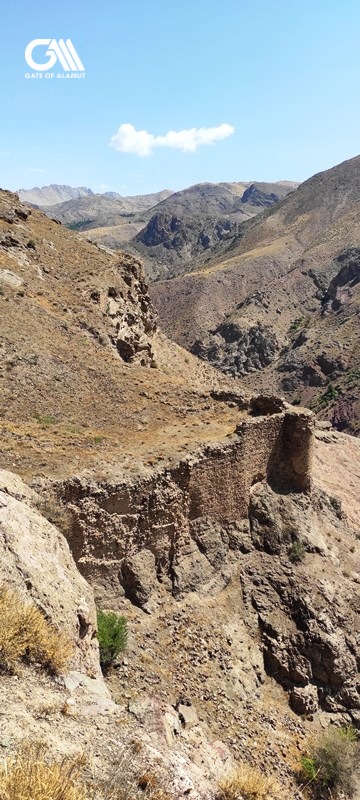
Topography of Lambsar
Lambsar itself lies on a small tributary of the Shahrud, the Na’inarud that flows into the Shahrud at Shahrestan-e Bala, some 5 kilometres from the actual site of Lamasar.
The fortress is in a similar geographical situation to Alamut in that it stands on a large, rocky outcrop at the head of a valley with a high range of mountains behind.
But in other respects it appears quite different from the other Ismaili castles. Instead of being perched on top of a great peak as at Alamut and Nevisar Shah, or hollowed out of the rock like Maymundez, Lamasar stands no more than 140 metres above the Shahrud.
Lambesar castle occupies a large area and, at its longest point from the northern walls to the southern defences, it covers almost 550 metres and at its widest 150 metres.
It stands on a rounded slope, which has an angle of 30 degrees. From Shahrestan-e Bala it is easy to get an overall view of the fortress, with the high citadel at the northern end of the slope, and on each side of the tilted table of rock, the ruins of towers, walls and other fortifications.
Lamyasar appears to have suffered somewhat less than the other castles at the hands of the Mongols.
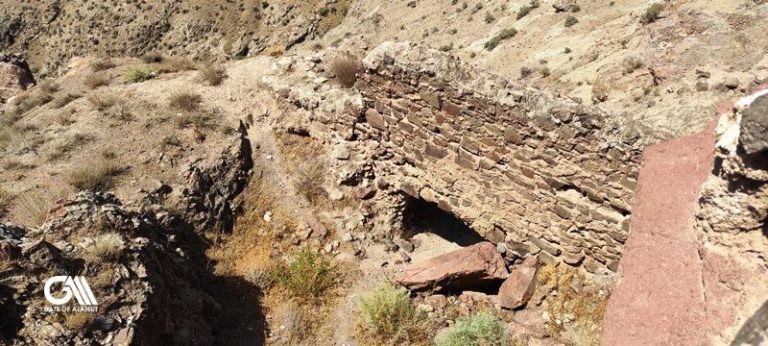
Capture of Lambesar Castle
From a distance, Lamasar seems very much like a traditional Norman castle, and it is an imposing sight.
Juwayni tells us that there had been a castle at Lamasar for some time before Hasan Sabbah took possession of Alamut and that the lord of Lamasar refused to be converted to the Ismaili cause.
Consequently, a small body of troops went under Bozorg-Ommid to take the castle. Juwayni relates that these men climbed up by stealth into the castle on the night of 10 September
1102 and overcame the inhabitants. Bozorg-Ommid commanded the Ismaili garrison
at Lamasar for many years – Juwayni explicitly states 20 years – until Hasan Sabbah fell ill and nominated him as his successor.
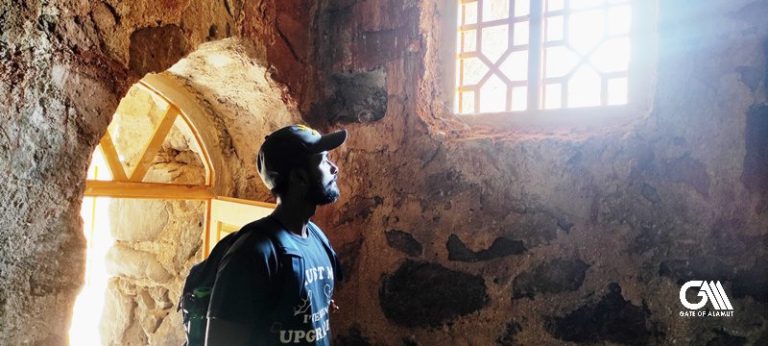
Fall of Lambesar
After the fall of Maymundez and Alamut to the Mongols in 1256, Lamasar continued to hold out for another year.
Hulegu Khan stayed for some time in the village of Mansurbagh, hoping that the castle’s occupants might soon be persuaded to creep serpent-like out of their holes.
But this hope was vain and it was only after a cholera epidemic that took the lives of many defenders of Lamasar that the remainder of its garrison surrendered.
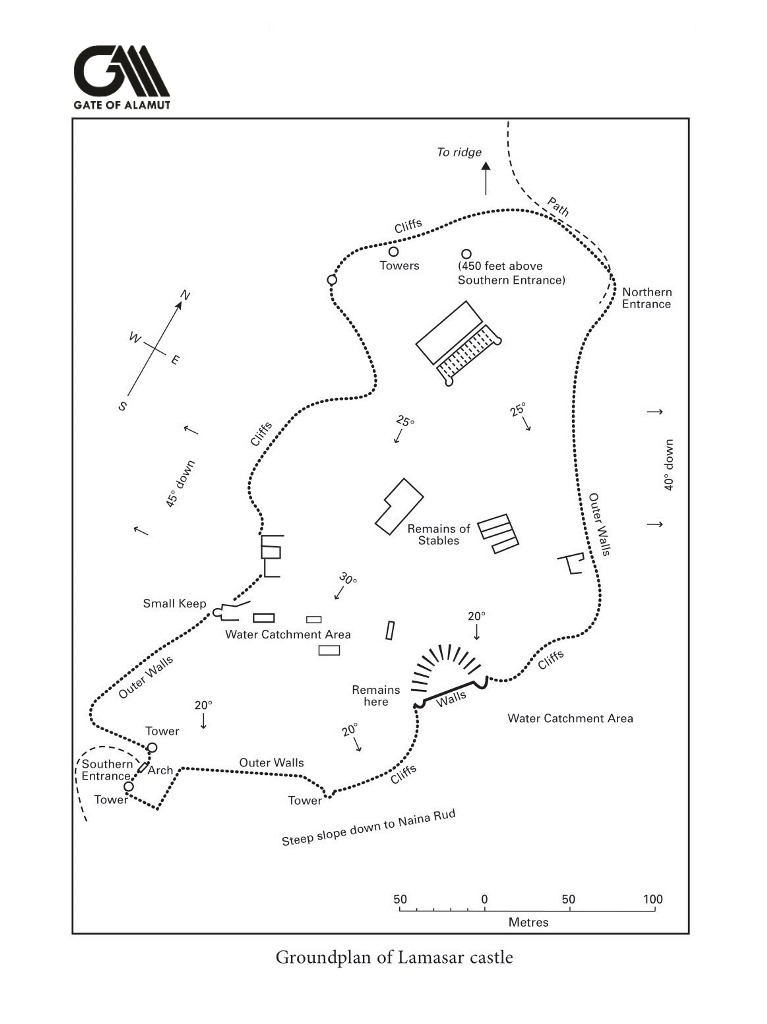
Lambsar Castle Architecture
Mansurbagh is the nearest village to Lamasar. From here it is possible to scramble across a series of irregular ditches, cross the Na’inarud and climb to the southern entrance of the castle over steep scree.
The principal guardhouse is here, though its main entrance is relatively small, no more than 2 metres high and 1 metre wide, which must have caused considerable difficulties for loaded pack-mules.
There are, in fact, two gateways, an inner and an outer one, both built on the same slope, the higher one 6 metres above the lower. They each face a different angle, thus making a bent entrance.
Just beside the guardhouse are two towers, part of the defensive system which runs round the whole fortress area.
The outer walls of the castle, which are obvious, rise steeply a the south-western end and skirt a massive stone building with an apsidal projection built on the edge of sheer cliff.
Former travelers have suggested that this was probably a residence, and Freya Stark called it on her accompanying plan a ‘serai’.
Professor Ivanow’s suggestion that it is more likely to be part of the fortifications of the ridge is probably correct.
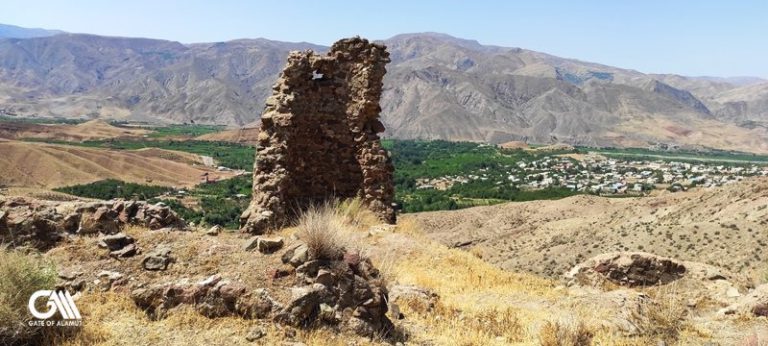
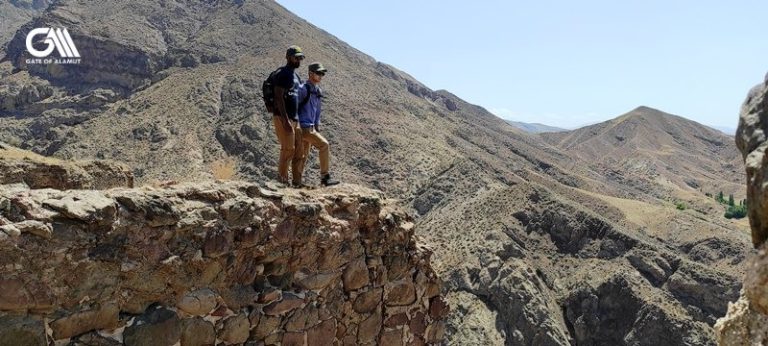
Structure of Lambesar
The rock type at Lamasar is of baked conglomerate. Then acid intrusions made some cut. The outcrop connects to the main mountain mass by a narrow neck of land.
The intrusions affect strata here quite much, and consequently there is not the smooth, steeply dipping slope into the prevailing winds as at Alamut.
In building the castle, however, the Ismaili engineers were still able to exploit the up-currents
of wind and the relief rain, which falls on the south and south-west faces of the fortress, by constructing water cisterns on the south-facing slope where the general inclination is not nearly as great as at Alamut.
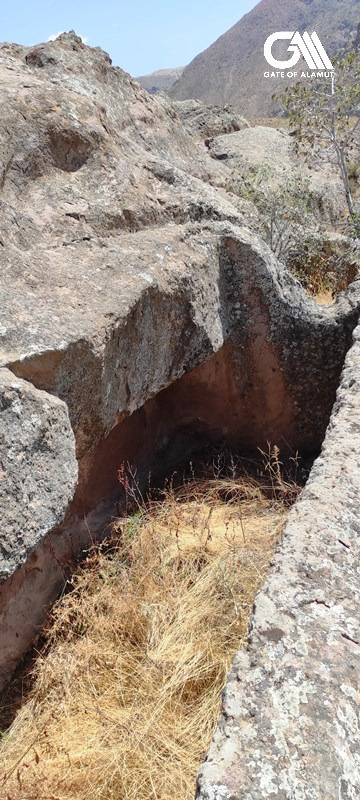

Magnificent Cisterns of Lambsar Castle
There are altogether 15 cisterns inside the rock at Lambsar, of which 11 are
on the southern face of the fortress.
Seven of these are interconnected with shallow water channels. They prevent each cistern from overflowing.
There are little round holes on their lips that once held posts to support rough shelters, as at Alamut, to prevent evaporation or pollution of the water. Around the great tanks of the cisterns, the marks left by countless picks are still visible.
These tanks are often 5.5 metres deep and sometimes four times as long; the connecting
channels are 15–20 centimetres wide. They have lined the remaining four cisterns with limestone and vaulted. With one exception, they are structurally higher
than the other seven and the fourth is at a distance away from the others.
It is possible that the Ismailis used these four plaster-lined cisterns for storing grain or other
foodstuff. There are four more water cisterns: two on the western side,
one on the north and another in the east.
The seven water cisterns at the southern end of the fortress intercept the flow off a catchment area of 9,700 square metres. If one assumes a similar rainfall to Alamut of about 100 centimetres per year, 11 million litres of water would fall on the area annually.
The storage capacity of these cisterns is, however, limited and estimated to be around 398,250 litres at any one time.
This is far less than at Alamut and there is no sign of underground water cisterns.
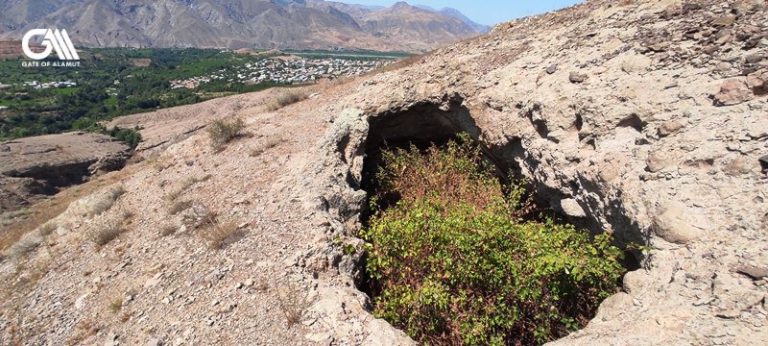
Qanat in Lambsar Castle
Careful examination of the rock at Lamasar revealed that there is a man-made qanat or water channel passing across the neck of land by which links the rock to the main mountain mass.
The qanat splits, one channel passing around the northern side of the castle and swinging round the eastern edge of the rock.
It is not possible to trace the channel very far round the eastern end, but it is possible
that it supplied a large cistern situated outside the castle walls, which overflows down a gully into the Na’inarud below.
The other branch of the qanat passes around the western side of the rock and it is clear some 20–30 metres below the castle walls from the south-west tower.
Inaccessibility made it impossible to trace this completely, but it seems probable that this qanat emptied into the cisterns along the western edge of the rock and may even have swung round to supplement the rainwater collected in the cisterns on the southern slopes of the rock.

How many men and horses could survive?
At Lamasar it seems as if much of the regular water supply came from the qanat, rainfall and water from the Na’inarud. In the dry, hot days of summer the garrison relied on the 398,250 litres of water. The Assassins stored the water in the seven covered cisterns.
This amount would be sufficient to keep 500 men and 50 mules and horses for three months. The garrison also drew water from the Na’inarud which runs to the east of the castle, and on the edge of the river they built a small tower 3 metres square guarding a narrow tunnel hewn out of the rock for a length of over 305 metres.
It connects with the catchment area on the south-eastern side of the castle.
This tower overhangs the river and in winter water could be collected in buckets. All sorts of improbable legends have connections with this tunnel.
There is a story that once, when the enemy besieged the garrison and the tower was in the hands
of the Seljuq, Ismailis sent sheep down through the tunnel to the river. The sheep had water bags strapped under their bellies and these bags were then filled in the river.
A shepherd in the pay of the garrison stood by, unsuspected by the invading forces, and as soon as they filled water bags, he set a wolf to chase the sheep back up the tunnel.
The tunnel is in fact far too steep for this to have happened, but it is a picturesque story.
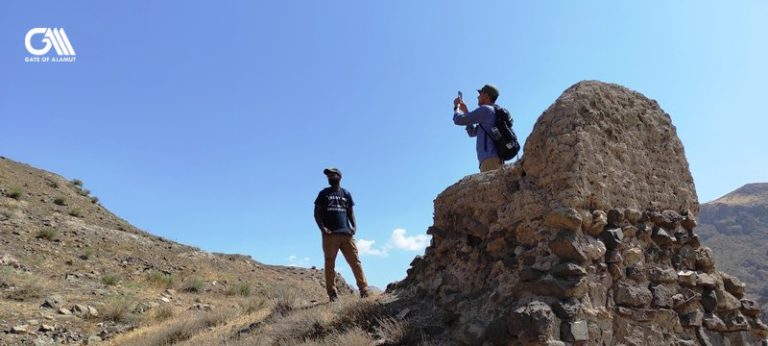
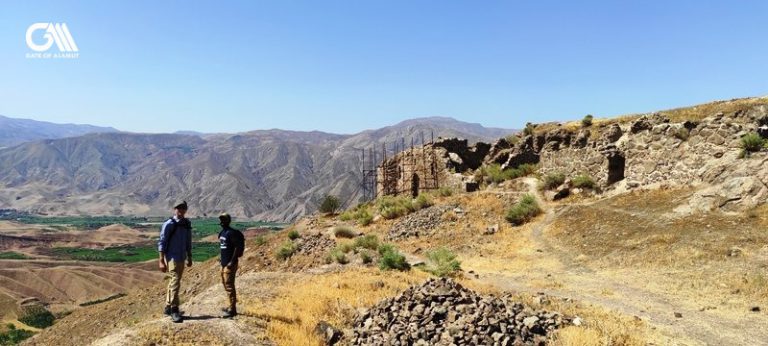
High Citadel of Lambsar Castle
Some 60 metres to the north is the main keep or high citadel, still in quite a good state of preservation.
It is a single-storey building built of stone and they covered the ground with rubble.
It occupies a space of about 30 metres by 24.5 metres.
The entrance has a rounded arch and inside there are two rooms. The left-hand room has a fine vault 3 metres high, 2 metres wide and 4 metres long.
The walls are one metre thick, and the floor was covered with rubble and shards of pottery when we visited it. Behind the building there are ruins of 12 other rooms, possibly storerooms, long and narrow.
Freya Stark observed a tower in the south-eastern corner.
To the north of the high citadel the ground rises again to the ruined towers of the northern entrance. The best view of the site is really possible from the top of an adjoining steep hill. The inclined plateau on which the castle stands, was a natural fortress in itself.
Set aside from the surrounding countryside, it arises as a solid rock wall, a tilted slab with three sides that scarcely needed fortifying.
The eastern side is perhaps the most vulnerable, and it is easy to trace the line of the continuous defensive wall on this side.

The Shield To The Rear
The main importance of Lamasar in Ismaili military strategy was to provide what Ivanow called ‘the shield to the rear’ of the main Ismaili castles in Alamut.
It may also have been used as a base for reserve forces. The size of the fortress – it is
considerably larger than Alamut – and the complexity of its water system indicate
that a large garrison lived here.
The strategic purposes that Lamasar served did not in themselves demand a large force.
It is reasonable to assume, therefore, that the fortress had another function, such as the training of Ismail fida’is, although we have no actual evidence of this.
But it is equally difficult to believe that Lamasar was no more than a quiet backwater during the long period of Ismaili rule.
Three smaller forts protect the eastern approaches to Lamasar from attack.
Lambsar Castle – Alamut Valley – Iran

Special Thanks to my Indian Clients/Friends; Ranvijay and Armaan.
Are you interested to book an Alamut tour with me to explore Lambsar Castle in Alamut Valley?
You just need to touch the whatsapp or email icon at the bottom of this page.
Or go to the page Contact Us.
#alamut #alamout #alamot #ale_amut #ale_amoot #alamut_trip #alamut_tour #alamut_voyage #alamut_tours #alamut_castle #alamut_castles #alamut_history #alamut_fortress #alamut_valley #alamut_valley_tour #tour_to_alamut_valley #tour_to_alamut_castle #alamut_castle_tour #alamut_valley_guide #alamut_valley_local_guide #alamut_valley_history #assassins_history #assassins_history_iran #assassins_history_persia #castles_of_assassins #castles_of_assassins_iran #castles_of_assassins_persia #castles_of_assassins_history #history_of_assassins_iran #hashashin_persia #hashashin_order #hashashin_history #hashashin_assassins #best_alamut_guide #lambesar_castle_alamut #lamiasar_castle_alamut #lamisar_castle_alamut

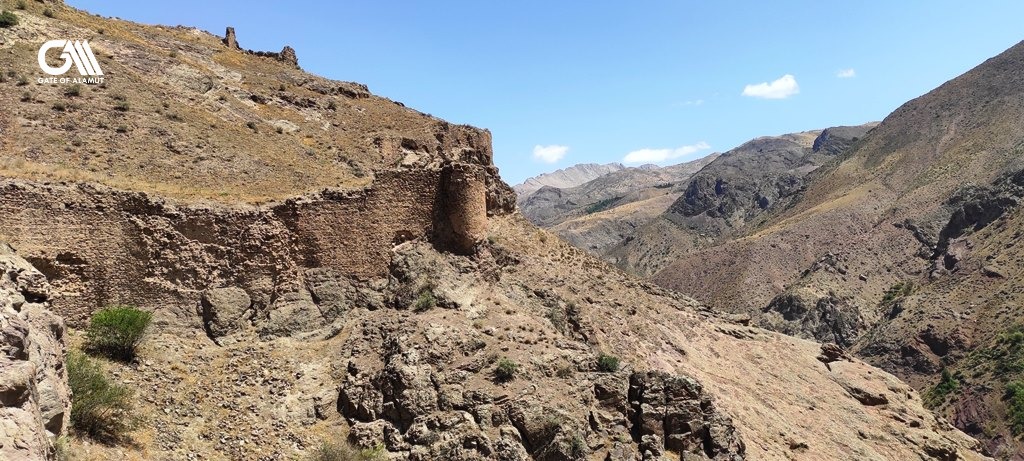
Pingback: Navizar Castle in Alamut Valley - The Unknown Castle of the Assassins
Pingback: Armaan in Alamut Valley - Gate of Alamut